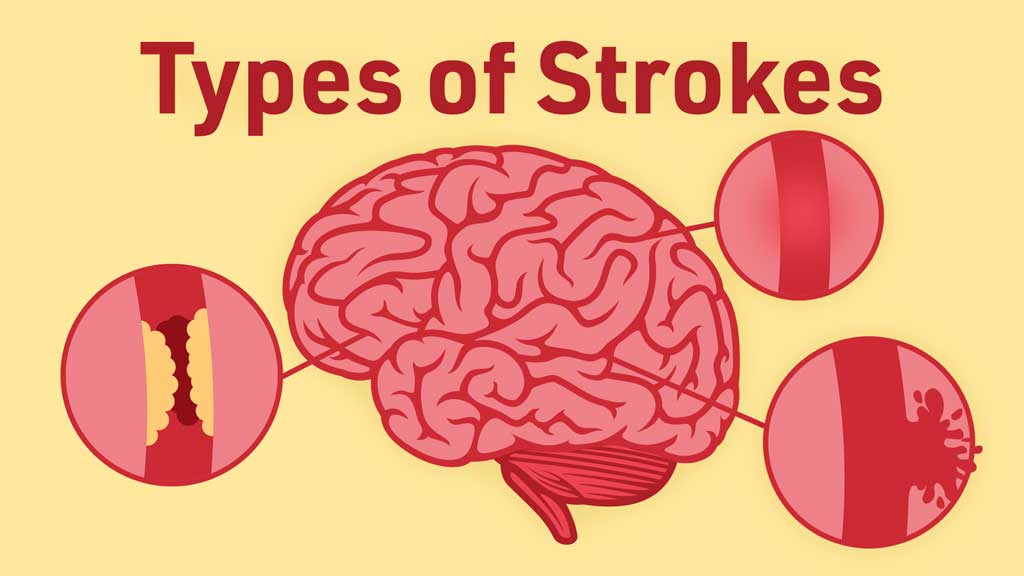
![]()
Strokes, also known as cerebrovascular accidents, occur when there is a disruption in the blood supply to the brain, leading to damage of brain tissue. There are several types of strokes, and understanding their distinctions is crucial for proper diagnosis and treatment. The two main types of strokes are ischemic and hemorrhagic, each with subtypes:
1. Ischemic Stroke:
Description: Ischemic strokes are caused by a blockage or clot that restricts blood flow to a part of the brain.
Subtypes:Thrombotic Stroke: Caused by a blood clot (thrombus) that forms within an artery supplying blood to the brain.
Embolic Stroke: Caused by an embolus (a clot or debris) that travels from another part of the body to the brain, blocking an artery.
2. Hemorrhagic Stroke:
Description: Hemorrhagic strokes occur when there is bleeding in the brain, often due to a ruptured blood vessel.
Subtypes:Intracerebral Hemorrhage: Bleeding occurs within the brain tissue, usually from a small artery.
Subarachnoid Hemorrhage: Bleeding occurs in the space between the brain and the tissues covering the brain (subarachnoid space), often caused by a ruptured aneurysm.
3. Transient Ischemic Attack (TIA):
Description: Often referred to as a “mini-stroke,” a TIA is a temporary disruption of blood flow to the brain, resulting in temporary symptoms similar to those of a stroke.
Characteristics: TIAs do not cause lasting damage, but they are considered warning signs that a more severe stroke may occur.
4. Cryptogenic Stroke:
Description: Cryptogenic strokes have an unknown cause, meaning the underlying reason for the stroke is not identified despite thorough investigations.
Characteristics: It may involve undetected emboli, vascular abnormalities, or other factors.
5. Embolic Stroke of Undetermined Source (ESUS):
Description: ESUS is a subtype of ischemic stroke where an embolic source is suspected but not identified despite extensive investigations.
Characteristics: ESUS is associated with a higher risk of recurrent strokes.
6. Hypoxic-Ischemic Encephalopathy (HIE):
Description: HIE results from a lack of oxygen and blood flow to the brain, often occurring during birth complications or cardiac arrest.
Characteristics: It is not exclusively a stroke but involves brain damage due to insufficient oxygen.
Important Points:
Risk Factors: Both ischemic and hemorrhagic strokes share common risk factors such as high blood pressure, smoking, diabetes, and age.
Emergency Response: Stroke is a medical emergency, and prompt treatment is essential. Recognizing symptoms (sudden numbness, confusion, trouble speaking, severe headache) and seeking immediate medical attention is crucial.
Diagnosis: Imaging tests, such as CT scans and MRI, are used to diagnose the type of stroke and guide treatment decisions.
Understanding the specific type of stroke is vital for determining the appropriate medical interventions, which may include medications, surgery, or other interventions to minimize brain damage and prevent further strokes.
A transient ischemic attack (TIA) is often referred to as a “mini-stroke” because it produces symptoms similar to those of a stroke but typically lasts only a short time, usually a few minutes to an hour. The symptoms of a TIA are temporary and do not cause permanent damage. However, they serve as warning signs that there may be an increased risk of a more severe stroke in the future. It’s crucial to recognize and seek medical attention promptly if you or someone else experiences symptoms of a TIA. Common symptoms include:
Sudden Weakness or Numbness: Location: Typically on one side of the body. Affected Areas: Face, arm, or leg. Difficulty Speaking or Slurred Speech: Speech Issues: Difficulty forming words, slurred speech, or inability to speak clearly.
Sudden Trouble Seeing: Vision Changes: Blurred vision, double vision, or sudden vision loss in one or both eyes. Loss of Coordination or Balance: Difficulty Walking: Sudden dizziness, loss of balance, or difficulty walking. Sudden Severe Headache: Intensity: A sudden, severe headache with no apparent cause.
It’s important to note that the symptoms of a TIA are similar to those of a stroke, but the main difference is that TIAs resolve on their own, usually within a short period. However, the occurrence of a TIA is a significant warning sign, and prompt medical attention is crucial to assess the underlying cause and reduce the risk of a more severe stroke.
If you or someone else experiences symptoms suggestive of a TIA, it is essential to seek emergency medical attention immediately. Do not ignore or downplay the symptoms, as timely intervention can help identify and manage risk factors, potentially preventing a future stroke.
Source: www.bing.com




